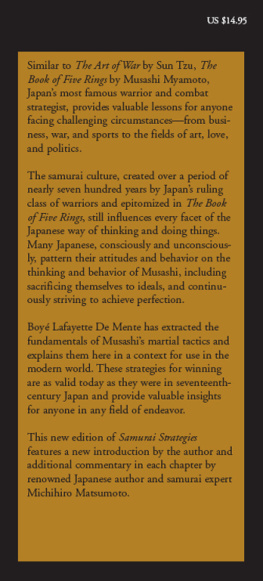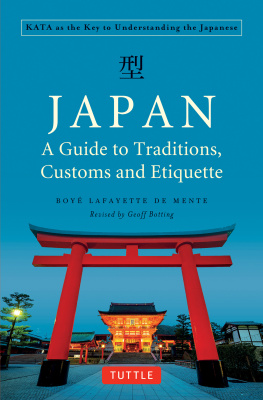Contents
|
|
1
|
|
|
2
|
|
The Way of the Gods 17 |
|
|
|
|
|
|
Learning the Roles and Rules 92 |
|
|
|
The New Playing Field 139 |
|
|
|
Japan Vs. the World 158 |
Published by Tuttle Publishing,an imprint of Periplus Editions (HK) Ltd. with editorial offices at 364 Innovation Drive, North Clarendon, VT 05759 U.S.A. and 61 Tai Seng Avenue, #02-12, Singapore 534167
Text Boy Lafayette De Mente, 2003
Front cover photo Gorazd Vilhar
First Tuttle edition, 2003
All rights reserved. No part of this publication may be reproduced or utilized in any form or by any means, eletronic or mechanical, including photocopying, recording, or by any information storage and retrieval system, without prior written permission of the publisher.
LCC Card No. 2004267142
ISBN 978-1-4629-0084-8
Distributed by:
Japan Tuttle Publishing
Yaekari Building 3F, 5-4-12 Osaki
Shinagawa-ku, Tokyo 141-0032
Tel: (81) 3 5437 0171; Fax: (81) 3 5437 0755
Email: tuttle-sales@gol.com
North America, Latin America and Europe
Tuttle Publishing
364 Innovation Drive
North Clarendon, VT 05759-9436
Tel: 1 (802) 773 8930; Fax: 1 (802) 773 6993
Email: info@tuttlepublishing.com
www.tuttlepublishing.com
Asia Pacific
Berkeley Books Pte Ltd
61 Tai Seng Avenue, #02-12 Singapore 534167
Tel: (65) 6280 1330; Fax: (65) 6280 6290
Email: inquiries@periplus.com.sg
www.periplus.com
14 13 12 11 10 9 8 7 6 5
Printed in Singapore
TUTTLE PUBLISHING is a registered trademark of Tuttle Publishing, a division of Periplus Editions (HK) Ltd.
"A unique look at a unique culture. If you're trying to figure the Japanese out, this book provides another important piece of the puzzle."
Terrie Lloyd, Founder & Publisher, J@pan Inc.;
CEO, LINC Media, Tokyo
Form (kata) over substance" has long been a guidepost to understanding Japan but Boy Lafayette De Mente, in KATA , paints a convincing picture of consciously nurtured forms prescribing behavior and methodology as a cultural and psychological hallmarkthe source of both great strengths and great limitations. Even long-time students of Japan will find the book illuminating and thought-provoking."
Sam Jameson, former Tokyo Bureau Chief of the Chicago Tribune and the Los Angeles Times
"Among the numerous books by foreigners on the intricate Japanese mindscapes and businessscapes, Boy Lafayette De Mente's KATA: The Key to Understanding & Dealing with the Japanese! is undoubtedly the most informative and eye-opening; it is rich in exploratory insight and provocative wisdom."
-Dr. Tae-Chang Kim, President, Institute
for the Integrated Study of Future Generations, Kyoto
"In working with the most traditional sectors of the Japanese economy (real estate and construction), where few foreigners ever penetrate, I have experienced the gorge of misunderstanding between Japan and the rest of the world. KATA explains the rationale for Japanese behavior and fills in the blanks for everyone, including long-term foreign residents."
James Fink, General Manager, Colliers Halifax, Tokyo
"I have been acting as a bridge between Japanese and foreign businessmen for nearly forty years. This book says what I have been trying to say all those years."
Tokuo Maruoka, Former Director, Price
Waterhouse Japan; Founder & Chairman, Comito Inc., Tokyo
Boy Lafayette De Mente first went to Japan in 1949 as a member of a U.S. military intelligence agency, and has been involved with the country ever since as a student, journalist, editor, lecturer and writer. He is the author of more than thirty books on Japan, including Japanese Etiquette & Ethics in Business (1959) and How to Do Business With the Japanese (1962), the first books ever on the Japanese way of doing business.

1
The Kata Factor
Japan's Secret Weapon
S HIKATA (she-kah-tah) is one of the most used and most important words in the Japanese language. It means "way of doing things," with special emphasis on the form and order of the process. The root meaning of shi is a combination of "support" and "serve" in the sense of an inferior supporting and serving a superior. Kata, by itself, is usually translated as "form."
Some of the more common uses of kata include yomi kata (yoh-me kah-tah) or "way of reading;" tabe kata (tah-bay kah-tah), "way of eating;" kaki kata (kah-kee kah-tah), "way of writing;" kangae kata (kahn-guy kah-tah), "way of thinking;" and iki kata (ee-kee kah-tah), "way of living."
There are dozens of other kata. In fact, there is hardly an area of Japanese thought or behavior that is not directly influenced by one or more kata.
When used in the Japanese context the shikata concept includes more than just the mechanical process of doing something. It also incorporates the physical and spiritual laws of the cosmos. It refers to the way things are supposed to be done, both the form and the order, as a means of expressing and maintaining harmony in society and the universe.
The absence of shikata is virtually unthinkable to the Japanese, for that refers to an unreal world, without order or form. On an everyday level, when the Japanese are faced with something that cannot be changed or controlled (or for some reason they don't want to make the necessary effort) they say, Shikata ga nai ("There is no way")meaning it is utterly hopeless and therefore makes no sense even to try.
Early in their history the Japanese developed the belief that form had a reality of its own, and that it often took precedence over substance. They also believed that anything could be accomplished if the right kata was mentally and physically practiced long enough.
"Japan has no genuine philosophy as such, only form," says Kazuo Matsumura, assistant professor of Japanese mythology at the Oyasato Institute at Tenri University in Nara. He adds, however, that most Japanese today are ignorant of the roots of much of their kata-ized behavior.
The sum total of all the kata in Japanese life has traditionally been referred to as "The Japanese Way." It was the existence of this very conspicuous "way" that provided the Japanese with some of their most enviable as well as their most negative attributes, and distinguished them from other nationalities.
Most of Japan's numerous kata have been well established for centuries. Over the generations the kata not only became institutionalized; they also became ritualized and sanctified. Doing things the right way was often more important than doing the right things!




















